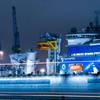Paragon Engineering Services, Inc. recently offered support of Atlantia Offshore on the TotalFinaElf E&P USA, Inc. Matterhorn project in the Gulf of Mexico.
"Atlantia is focused on delivering a turnkey package for a reliable, fit-for-purpose solution for deepwater field developments, with strong emphasis on cost, schedule and operational success," said , Bill Wenger, Paragon project manager. "Paragon has adapted to this culture, using its electronic work process systems to ensure better integration with the fabrication phase, and to deliver timely completion and avoidance of any costly rework."
The TotalFinaElf-operated Matterhorn Deepwater Production Facility project calls for the installation of a mono-column tension-leg platform (TLP) on Mississippi Canyon Block 243 in 2,835 ft. of water. Atlantia Offshore of Houston has a lump-sum turnkey contract to deliver the facility for installation in summer 2003.
Representing Atlantia's first dry tree TLP, and its fourth TLP using its SeaStar mono-column TLP design concept, the platform will be capable of supporting up to nine surface trees and future subsea well tie-backs. The Matterhorn platform will accommodate workover/completion operations and production of 33,000 barrels of oil per day and 55 million standard cu. ft. of gas per day.
Atlantia's turnkey contract encompasses the complete TLP package, including the hull, piles, tendons, deck and topsides. Mitch Provost, Atlantia's facilities project engineer for Matterhorn, advises that the project scope includes: Design/engineering; Procurement; Fabrication at multiple sites around the world; Platform assembly in Texas; Offshore installation; and Commissioning.
Atlantia has subcontracted Paragon to provide facilities design/engineering for Matterhorn, which requires approximately 60,000 man-hours. Facilities dry weight is expected to exceed 3,000 tons upon completion. Total topsides weight is 6,000 tons. For the balance of the project, Paragon will support Atlantia with fabrication oversight and pre-commissioning assistance.
As an example of technical innovation, Provost notes Paragon's unique grid design for a pipe rack support system. To facilitate the schedule and pipe installation, Paragon's piping group designed the pipe racks using a flexible grid design under each of the three main decks with pre-planned zones for piping and cable tray interconnects.
"Development of the pipe rack support system demonstrates how Paragon pushes efficiency into design, providing a really clean design that is easy to understand and to build," said Provost.
Wenger adds that the Atlantia business culture emphasizes the importance of on-time design and procurement of reliable facilities, with minimal development cost and minimal difficulties during fabrication. To achieve this goal, Wenger advises that Paragon has integrated its staff into the larger Matterhorn team, consisting of TotalFinaElf's Matterhorn project team, the Atlantia topsides and hull engineering groups and Atlantia procurement and construction management personnel, many of whom perform dual roles during both the design and fabrication/construction phases of the project.
"The bottom line for Atlantia doesn't stop with engineering; it continues through fabrication, start-up and operations to ensure optimal performance within the budget scope," said Wenger.
A project challenge for Paragon on Matterhorn, says Stan Hoggatt, Paragon project engineer, has been designing topside equipment, piping and interconnects for very congested areas, due to the facility's limited clearance between each of its three decks and the sub-cellar deck.
Atlantia strives to keep the vertical center of gravity as low as possible to maximize platform payload capacity. The deck levels have a separation of 25 feet with 4 feet deep girders, leaving up to 21 feet for equipment, cable trays, pipe racks, etc.
"We're completing this effort in the midst of a very tight schedule," said Hoggatt. In terms of designing facilities for the deepwater floating arena, through the Matterhorn project, Paragon is building on its experience with the regulatory environment specific to floating platforms.
As with other floater projects, Paragon is observing Title 46 of the Code Federal Regulations (CFRs) under the U.S. Department of Transportation in its engineering/ design of the topside facilities. This federal document governs shipping and criteria that pertain to vessel construction, including mobile offshore drilling and production units. Paragon's work has included constant interface with ABS, an international classification society.
Paragon has worked with ABS many times since completing its first floating production storage/offloading (FPSO) topside design in 1985, which was among the first topsides certified by ABS.
Regulatory distinctions for Paragon's scope of work, adds Wenger, relate mostly to "safety at sea" regulations, and the preparation of documents for ABS, which acts on behalf of the Coast Guard in this review process.
Featured videos

Inside the Electrified Truckable Tug

Inmarsat Enhances Service to Drive Digitalization

Tracking Foreign Vessels Working in the U.S. Jones Act Market
Subscribe for
Maritime Reporter E-News
Maritime Reporter E-News is the maritime industry's largest circulation and most authoritative ENews Service, delivered to your Email five times per week









